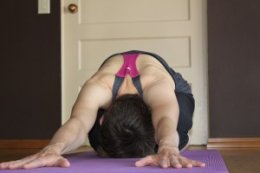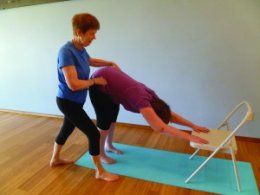
 Sunday, 19th, 2014
Sunday, 19th, 2014
Guest post by Margaret Callahan
Scoliosis is a common, confusing and often misunderstood condition of the spine. Simply put, it is a side to side (left and/or right) curvature of the spine. There are two main types of scoliosis. With structural scoliosis there is an actual change in the bony structure that initially causes the spine to curve, usually in the thoracic or lumbar areas. Then, two more curves usually develop which are compensatory curves; that is, these curves attempt to bring the spine back to some sort of vertical position. The second type of scoliosis is functional and is usually caused by habitual, asymmetrical movement patterns that cause a muscular imbalance and then a curvature. When the spine begins its ‘song’ with its side to side curves in scoliosis, there is also usually a rotation of the spine and then ribs. These changes might cause a noticeable ‘rib hump’ on the back, a caving in of the chest, uneven hips, apparent (but not real) leg length differences, one shoulder higher than the other, uneven breasts, etc. There is often accompanying achiness or pain in the back, shoulders, hips, neck, and/or legs.
 What causes scoliosis is not well understood except in a fairly small percentage of cases. It has generally been thought that it develops when one is a teenager. But recently, perhaps due to our aging population, there are numerous older folks who are being diagnosed with ‘late onset’ scoliosis.
What causes scoliosis is not well understood except in a fairly small percentage of cases. It has generally been thought that it develops when one is a teenager. But recently, perhaps due to our aging population, there are numerous older folks who are being diagnosed with ‘late onset’ scoliosis.
Treating scoliosis is more complex than telling someone to ‘stand up straight, ’ or ‘you need to work on your abs.’ There are 24 vertebrae in the back and there can be any number of unique and creative ways the spine will curve and rotate in this condition. While I have been practicing yoga for about 30 years (yikes!) I didn’t realize I had scoliosis until about 6 years ago. As I began to understand my own back and its own ‘song’ (often in a minor key) I was fortunate to be able to begin studying with Elise Miller ( in 2011. Since then I have studied with her at her Yoga for Scoliosis 1 and 2 Workshops and an Advanced Yoga for Scoliosis Teacher’s Retreat. Because scoliosis is so complex, I continue to study and attend workshops. I enjoy passing my knowledge on by teaching Yoga for Scoliosis classes. Learning about my own back and how it works, or at times, doesn’t work, helps me understand others who also have scoliosis.
Yoga is a perfect vehicle to work with the complexity and nuances of scoliosis. The first principle is to lengthen the spine and begin to create space in the spine and in the body. Next is strengthening the muscles, and then working on de-rotation of the spine. No two people have the exact same curves, so specific adjustments and modifications to the poses are important. Coming to classes specifically for scoliosis can give a person awareness and tools for some simple home yoga poses. Continuing yoga classes which focus on alignment, and/or private yoga sessions is also important. Persistence and commitment to the practice of yoga are essential and can bring improvements of alignment and balance, and reduce discomfort/pain.









